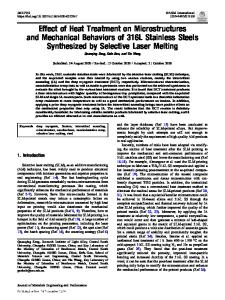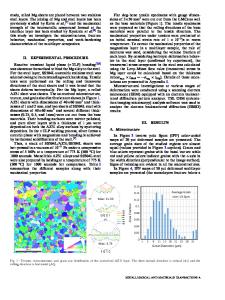Microstructures and Mechanical Properties of Nanostructured Copper-304 Stainless Steel Multilayers Synthesized by Magnet
- PDF / 1,742,863 Bytes
- 6 Pages / 612 x 792 pts (letter) Page_size
- 19 Downloads / 368 Views
I2.8.1
Microstructures and Mechanical Properties of Nanostructured Copper-304 Stainless Steel Multilayers Synthesized by Magnetron Sputtering X. Zhang, A. Misra, H. Wang, H. Kung, J. D. Embury, R. G. Hoagland and M. Nastasi Materials Science and Technology Division, Mail Stop G755, Los Alamos National Laboratory, Los Alamos, NM 87545 Abstract Nanostructured Cu/304 stainless steel (SS) multilayers were prepared by magnetron sputtering at room temperature. 304SS has a face-centered cubic (fcc) structure in bulk. However, in the Cu/304SS multilayers, the SS layers exhibited fcc structure for layer thickness of less than or equal to 5 nm. For 304SS layer thickness larger than 5nm, bcc 304SS grains were observed to grow on top of the initial ≈ 5 nm of fcc SS. The maximum hardness of Cu/304SS multilayers was ≈ 5.5 GPa (factor of two enhancement compared to rule of mixtures hardness) achieved at a layer thickness of 5nm, with a decrease in hardness with decreasing layer thickness below 5 nm. The hardness of fcc/fcc Cu/304SS multilayers (layer thickness ≤ 5 nm) is compared with Cu/Ni, another fcc/fcc system, to gain insight on how the mismatch in physical properties such as lattice parameters and shear moduli of the constituent layers affect the peak hardness achieved in these nanoscale systems. Introduction Nanostructured multilayers are made up of alternating nanometer scale layers of two different materials. The layer thickness can be well controlled in the scale of 1nm or less by physical vapor deposition (PVD). These nanostructured multilayers have novel mechanical, electrical, magnetic, and optical properties [1-3]. The mechanical properties of these multilayered composites are of particular interest since the strength of these multilayer composites can be significantly increased to about 1/3 of the theoretical strength limit [4]. In the µm to the sub-µm length scale regime, the strengthening in these multilayers can be explained by the Hall-Petch model of dislocation pile-ups at interfaces or grain boundaries. The yield strength, σy, is proportional to h −1 / 2 , where h is the layer thickness [5,6]. Hall-Petch slope is a measure of the strength of interface barrier for dislocation pile-ups and determines the rate of strength increase with decreasing h. However, in the tens of nanometers regime the Hall-Petch model breaks down [1]. The deformation mechanism may involve glide of single dislocations, in the form of Orowan loops, leading to σy ∝ ln(h)/h relation [4,7]. In the limit of a few nanometers, the strength of the multilayer may be determined by the stress to transmit a single dislocation across the interfaces. Factors such as shear modulus mismatch and lattice parameter mismatch may determine the transmission stress for single dislocations. For multilayers with a large difference between shear modulus, dislocations in the low shear modulus phase need to overcome a high repulsive stress (Koehler stress) to enter the high modulus phase [8]. Furthermore, coherency stresses within the thin lattice matched multilay
Data Loading...











